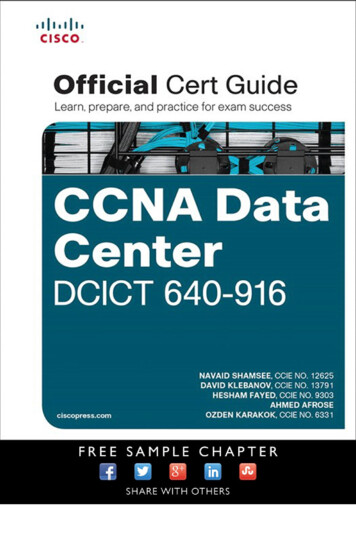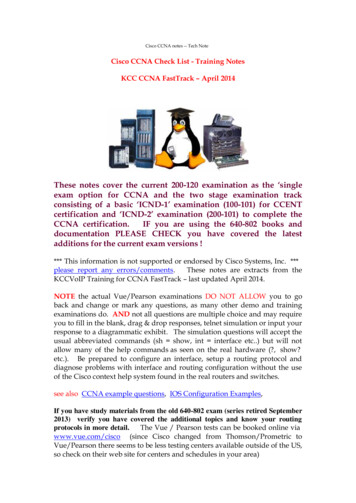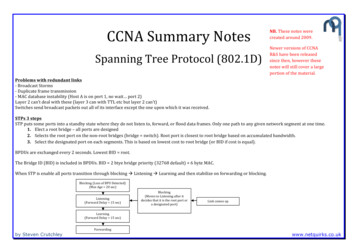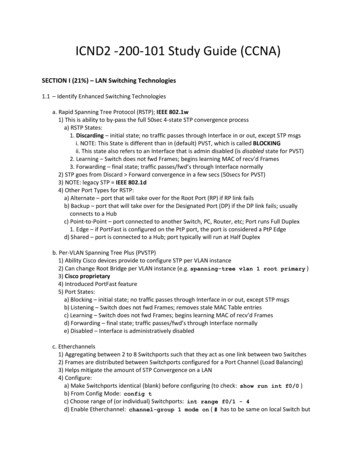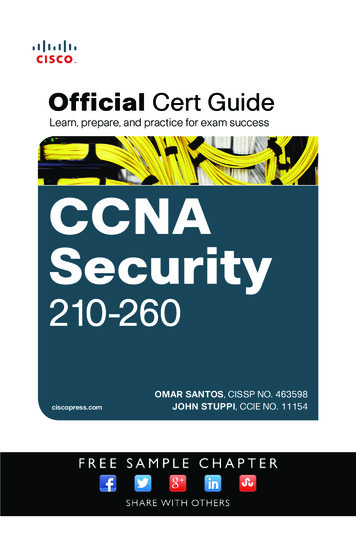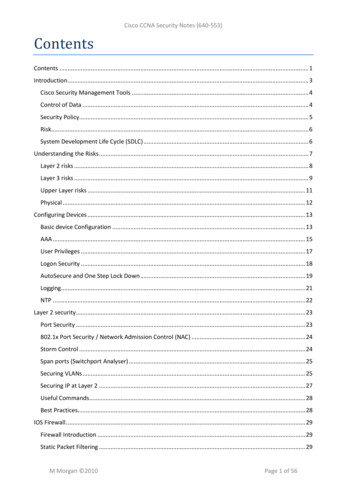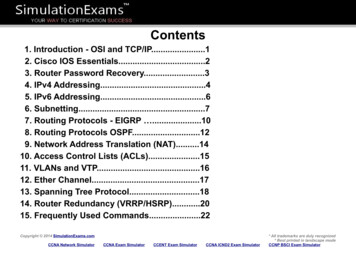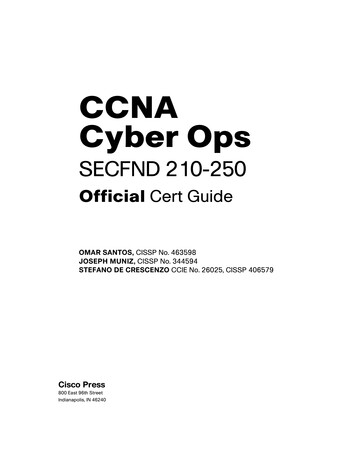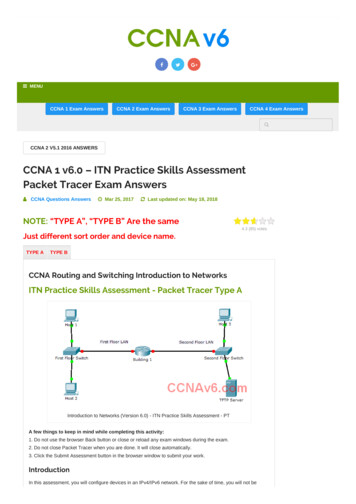
Transcription
MENUCCNA 1 Exam AnswersCCNA 2 Exam AnswersCCNA 3 Exam AnswersCCNA 4 Exam Answers CCNA 2 V5.1 2016 ANSWERSCCNA 1 v6.0 – ITN Practice Skills AssessmentPacket Tracer Exam Answers CCNA Questions Answers Mar 25, 2017 Last updated on: May 18, 2018NOTE: “TYPE A”, “TYPE B” Are the same4.3 (85) votesJust different sort order and device name.TYPE ATYPE BCCNA Routing and Switching Introduction to NetworksITN Practice Skills Assessment - Packet Tracer Type AIntroduction to Networks (Version 6.0) - ITN Practice Skills Assessment - PTA few things to keep in mind while completing this activity:1. Do not use the browser Back button or close or reload any exam windows during the exam.2. Do not close Packet Tracer when you are done. It will close automatically.3. Click the Submit Assessment button in the browser window to submit your work.IntroductionIn this assessment, you will configure devices in an IPv4/IPv6 network. For the sake of time, you will not be
asked to perform all configurations on all network devices as you may be required to do in a real network or otherassessment. Instead, you will use the skills and knowledge that you have learned in the labs in this course toconfigure the Building 1 router. In addition, you will address the hosts on two LANs with IPv4 and IPv6addresses, activate and address the management interface of the Second Floor Switch, and back up a deviceconfiguration to a TFTP server.You will receive one of several topologies.You are not required to configure the First Floor Switch, and you will not be able to access it in thispractice skills assessment activity.All IOS device configurations should be completed from a direct terminal connection to the deviceconsole. In addition, many values that are required to complete the configurations have not been givento you. In those cases, create the values that you need to complete the requirements. For values thathave been supplied to you, they must be entered exactly as they appear in order for you to get full creditfor your configuration.You will practice and be assessed on the following skills: Configuration of initial IOS device settings Design and calculation of IPv4 addressing Configuration of IOS device interfaces including IPv4 and IPv6 addressing when appropriate Addressing of network hosts with IPv4 and IPv6 addresses Enhancing device security, including configuration of the secure transport protocol for remote deviceconfiguration Configuration of a switch management interfaceRequirements by device:Building 1 router: Configuration of initial router settings Interface configuration and IPv4 and IPv6 addressing Device security enhancement or device hardening Secure transport for remote configuration connections as covered in the labs Backup of the configuration file to a TFTP serverSecond Floor Switch: Enabling basic remote management by TelnetPC and Server hosts: IPv4 full addressing IPv6 addressingAddressing Table
InstructionsStep 1: Determine the IP Addressing Scheme.Recommended: Use VLSM Calculator OnlineDesign an IPv4 addressing scheme and complete the Addressing Table based on the following requirements.Use the table to help you organize your work.
a. Subnet the 192.168.1.0/24 network to provide 30 host addresses per subnet while wasting the fewestaddresses.b. Assign the fourth subnet to the First Floor LAN.c. Assign the last network host address (the highest) in this subnet to the G0/0 interface on Building 1.(192.168.1.126)d. Starting with the fifth subnet, subnet the network again so that the new subnets will provide 14 host addressesper subnet while wasting the fewest addresses.e. Assign the second of these new 14-host subnets to the Second Floor LAN.f. Assign the last network host address (the highest) in the Second Floor LAN subnet to the G0/1 interface ofthe Building 1 router. (192.168.1.158)g. Assign the second to the last address (the second highest) in this subnet to the VLAN 1 interface of theSecond Floor Switch. (192.168.1.157)h. Configure addresses on the hosts using any of the remaining addresses in their respective subnets.Step 2: Configure the Building 1 Router.a. Configure the Building 1 router with all initial configurations that you have learned in the course so far: Configure the router hostname: Middle Protect device configurations from unauthorized access with the encrypted privileged exec password. Secure all access lines into the router using methods covered in the course and labs. Require newly-entered passwords must have a minimum length of 10 characters. Prevent all passwords from being viewed in clear text in device configuration files. Configure the router to only accept in-band management connections over the protocol that is more securethan Telnet, as was done in the labs. Use the value 1024 for encryption key strength. Configure local user authentication for in-band management connections. Create a user with the namenetadmin and a secret password of Cisco CCNA5 Give the user the highest administrative privileges. Youranswer must match these values exactly.b. Configure the two Gigabit Ethernet interfaces using the IPv4 addressing values you calculated and the IPv6values provided in the addressing table. Reconfigure the link local addresses to the value shown in the table. Document the interfaces in the configuration file.Step 3: Configure the Second Floor Switch.Configure Second Floor Switch for remote management over Telnet.Step 4: Configure and Verify Host Addressing.a. Use the IPv4 addressing from Step 1 and the IPv6 addressing values provided in the addressing table toconfigure all host PCs with the correct addressing.b. Use the router interface link-local address as the IPv6 default gateways on the hosts.Step 5: Backup the Configuration of the Building 1 Router to TFTP.a. Complete the configuration of the TFTP server using the IPv4 addressing values from Step 1 and the values inthe addressing table.b. Backup the running configuration of Building 1 to the TFTP Server. Use the default file name.AnswersHost 1IPv4 192.168.1.97 255.255.255.224GWv4 192.168.1.126IPv6 2001:DB8:ACAD:A::FF/64GWv6 FE80::1
Host 2IPv4 192.168.1.98 255.255.255.224GWv4 192.168.1.126IPv6 2001:DB8:ACAD:A::15/64GWv6 FE80::1
Host 3IPv4 192.168.1.145 255.255.255.240GWv4 192.168.1.158IPv6 2001:DB8:ACAD:B::FF/64GWv6 FE80::1TFTP ServerIPv4 192.168.1.146 255.255.255.240GWv4 192.168.1.158IPv6 2001:DB8:ACAD:B::15/64GWv6 FE80::1
Secon Floor Switch (or LAB 214-A Switch):Use line console to connect Host 3 and Second Floor Switch. On Host 3, go to "Desktop Tab" -- choice"Terminal"enableconf terminalenable secret class12345service password-encryptionbanner motd Second Floor Switch no ip domain-lookupline console 0password cisco12345loginlogging synchronousexec-timeout 60exitline vty 0 15password cisco12345loginlogging synchronousexec-timeout 60exitinterface vlan 1ip address 192.168.1.157 255.255.255.240no shutdownip default-gateway 192.168.1.158exitwriteCCNA Routing and Switching Introduction to Networks
ITN Practice Skills Assessment - Packet Tracer Type BITN Practice Skills Assessment - Packet TracerA few things to keep in mind while completing this activity:1. Do not use the browser Back button or close or reload any exam windows during the exam.2. Do not close Packet Tracer when you are done. It will close automatically.3. Click the Submit Assessment button in the browser window to submit your work.IntroductionIn this assessment, you will configure devices in an IPv4/IPv6 network. For the sake of time, you will not beasked to perform all configurations on all network devices as you may be required to do in a real network or otherassessment. Instead, you will use the skills and knowledge that you have learned in the labs in this course toconfigure the Town Hall router (or CS Department Router). In addition, you will address the hosts on two LANswith IPv4 and IPv6 addresses, activate and address the management interface of the Administration Switch (orLAB 214-A Switch), and back up a device configuration to a TFTP server.
You will receive one of several topologies.You are not required to configure the IT Department Switch, and you will not be able to access it in thispractice skills assessment activity.All IOS device configurations should be completed from a direct terminal connection to the deviceconsole. In addition, many values that are required to complete the configurations have not been givento you. In those cases, create the values that you need to complete the requirements. For values thathave been supplied to you, they must be entered exactly as they appear in order for you to get full creditfor your configuration.You will practice and be assessed on the following skills: Configuration of initial IOS device settings Design and calculation of IPv4 addressing Configuration of IOS device interfaces including IPv4 and IPv6 addressing when appropriate Addressing of network hosts with IPv4 and IPv6 addresses Enhancing device security, including configuration of the secure transport protocol for remote deviceconfiguration Configuration of a switch management interfaceRequirements by device:Town Hall router (or CS Department Router): Configuration of initial router settings Interface configuration and IPv4 and IPv6 addressing Device security enhancement or device hardening Secure transport for remote configuration connections as covered in the labs Backup of the configuration file to a TFTP serverAdministration Switch (or LAB 214-A Switch): Enabling basic remote management by TelnetPC and Server hosts: IPv4 full addressing IPv6 addressingAddressing Table
InstructionsStep 1: Determine the IP Addressing Scheme.Recommended: Use VLSM Calculator OnlineDesign an IPv4 addressing scheme and complete the Addressing Table based on the following requirements.Use the table to help you organize your work.a. Subnet the 192.168.1.0/24 network to provide 30 host addresses per subnet while wasting the fewestaddresses.b. Assign the fourth subnet to the IT Department LAN.c. Assign the last network host address (the highest) in this subnet to the G0/0 interface on Town Hall/CSDepartment . (192.168.1.126)d. Starting with the fifth subnet, subnet the network again so that the new subnets will provide 14 host addressesper subnet while wasting the fewest addresses.e. Assign the second of these new 14-host subnets to the Administration LAN.f. Assign the last network host address (the highest) in the Administration LAN subnet to the G0/1 interface ofthe Town Hall router. (192.168.1.158)g. Assign the second to the last address (the second highest) in this subnet to the VLAN 1 interface of theAdministration Switch (or LAB 214-A Switch) . (192.168.1.157)h. Configure addresses on the hosts using any of the remaining addresses in their respective subnets.Step 2: Configure the Town Hall router (or CS Department Router).a. Configure the Town Hall router (or CS Department Router) with all initial configurations that you have learnedin the course so far: Configure the router hostname: Middle
Protect device configurations from unauthorized access with the encrypted privileged exec password. Secure all access lines into the router using methods covered in the course and labs. Require newly-entered passwords must have a minimum length of 10 characters. Prevent all passwords from being viewed in clear text in device configuration files. Configure the router to only accept in-band management connections over the protocol that is more securethan Telnet, as was done in the labs. Use the value 1024 for encryption key strength. Configure local user authentication for in-band management connections. Create a user with the namenetadmin and a secret password of Cisco CCNA5 Give the user the highest administrative privileges. Youranswer must match these values exactly.b. Configure the two Gigabit Ethernet interfaces using the IPv4 addressing values you calculated and the IPv6values provided in the addressing table. Reconfigure the link local addresses to the value shown in the table. Document the interfaces in the configuration file.Step 3: Configure the Administration Switch (or LAB 214-A Switch).Configure Administration Switch (or LAB 214-A Switch) for remote management over Telnet.Step 4: Configure and Verify Host Addressing.a. Use the IPv4 addressing from Step 1 and the IPv6 addressing values provided in the addressing table toconfigure all host PCs with the correct addressing.b. Use the router interface link-local address as the IPv6 default gateways on the hosts.Step 5: Backup the Configuration of the Town Hall router (or CSDepartment Router) to TFTP.a. Complete the configuration of the TFTP server using the IPv4 addressing values from Step 1 and the values inthe addressing table.b. Backup the running configuration of Town Hall (or CS Department) to the TFTP Server. Use the default filename.AnswersReception Host (or 124-1)IPv4 192.168.1.97 255.255.255.224GWv4 192.168.1.126IPv6 2001:DB8:ACAD:A::FF/64GWv6 FE80::1Operator Host (or 124-5)IPv4 192.168.1.98 255.255.255.224GWv4 192.168.1.126IPv6 2001:DB8:ACAD:A::15/64GWv6 FE80::1IT Host (or 214-1)IPv4 192.168.1.145 255.255.255.240GWv4 192.168.1.158IPv6 2001:DB8:ACAD:B::FF/64GWv6 FE80::1TFTP ServerIPv4 192.168.1.146 255.255.255.240GWv4 192.168.1.158IPv6 2001:DB8:ACAD:B::15/64GWv6 FE80::1
Town Hall router (or CS Department Router)Use line console to connect Reception Host (or 124-1) and Town Hall router (or CS Department Router). OnReception Host (or 124-1), go to "Desktop Tab" -- choice "Terminal"enconf terminalhostname Middleenable secret class12345service password-encryptionbanner motd This is Router security passwords min-length 10login block-for 120 attempts 2 within 30no ip domain-lookupip domain-name ccnav6.comcrypto key generate rsa1024line console 0password cisco12345loginlogging synchronousexec-timeout 60exitline vty 0 4password cisco12345transport i
ITN Practice Skills Assessment - Packet Tracer A few things to keep in mind while completing this activity: 1. Do not use the browser Back button or close or reload any exam windows during the exam. 2. Do not close Packet Tracer when you are done. It will close automatically. 3. Click the Submit Assessment button in the browser window to submit your work.
